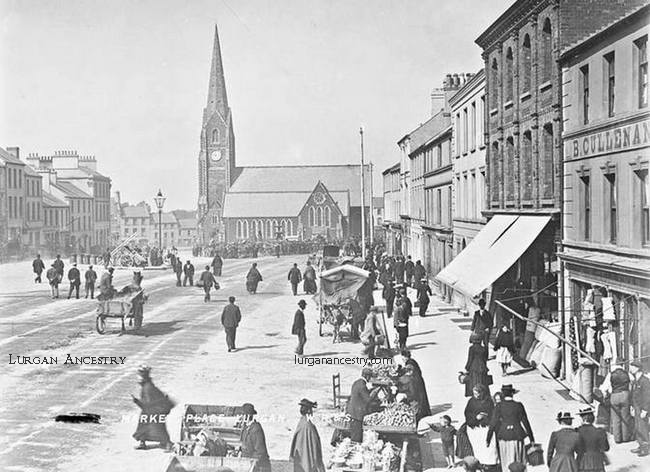The 1901 Lurgan Street Directory





Lurgan was a prosperous and flourishing manufacturing town by 1901. The population of Lurgan, according to the 1891 census, was 11,447. The correctness of these figures has been often questioned, the general belief being that the population in 1901 is over 14,000. The annual valuation of ratable property amounts, according to the last official information, to £25,190 13s, and the township is increasing in value. In the year 1831 the population of Lurgan was 3,760, and the ratable property was then £5,578, and since that time both the population and valuation has almost quadrupled.
The municipal affairs of Lurgan are managed by an Urban Council, incorporated under the Local Government (Ireland) Act, 1898, and the general cleanly appearance of the streets is evidence of the fostering care of the Municipal Council. The town is not picturesque, but its fine, open main streets, particularly from the Church to High Street, is a very observable feature in its formation. Fairs are held on the second Thursday of each month, and markets every Thursday. The market and fair are improving, and though the main street is very wide, it is taxed to its utmost, particularly on the days that the fair and market are held together. An unlimited supply of pure water is now obtained from Lough Neagh, the intake being at Castor Bay, on the south-east of the lake. The new works were opened in 1894, and in point of modern perfection they are pronounced to be second to none in the United Kingdom. Brownlow House and demesne (some 500 acres in extent), being now in the hands of a local syndicate, increased building accommodation has been provided, and desirable improvements are expected in the near future.
Among the industrial centres in Lurgan in 1901 are the extensive power-loom weaving factories of Mr. James Malcolm, D.L.; the Lurgan Weaving Company, Ltd.; Messrs. Johnston, Allen, & Co.; and the manufacturing concerns of Messrs. Robert Watson & Sons, John Douglas & Son, Samuel A. Bell & Co.; Mathers & Bunting, John Ross & Co.; James Clendinning & Sons, Richardson, Sons, & Owden; John S. Brown & Sons, Joseph Murphy & Co.; and the hemstitching factories of the Lurgan Hemming and Veining Company, John Ross & Co., Faloon & Co., James B. Hanna, J. Maxwell & Co., Murphy & Stevenson, Mercer & Brown, James Clendinning & Sons, Johnston, Allen, & Co.; Searight & Co., and Mathers & Bunting. The banking companies represented in Lurgan are the Ulster, the Northern, and the Belfast, each establishment having a branch office. The Church of Ireland, standing in the centre of the town, is a large and commodious Gothic structure, and has a fine peal of eight bells, in addition to an illuminated clock, which, from its commanding position, is visible from a long distance. An excellent Parochial Hall has been recently erected in Church Place, and there is also a handsome and spacious Church of Ireland Mission Hall and schoolhouse in John Street. There are, besides Lurgan College and the Model School, a large number of National schools, two of these being in immediate connection with St. Peter's Church and St. Joseph's Convent. There is also commodious houses or worship for Presbyterians, Methodists, Baptists, and Society of Friends, the Salvation Army and Plymouth Brethren.
The Town Hall is in Union Street, and contains an Assembly Hall, with platform and footlights; the Council Chamber and Town Office are located on the top floor; and the basement is devoted to the Free Library, the Newsroom, and Amusement Room, which are highly appreciated by the working men. The Mechanics' Institute is a handsome structure, situate at the corner of Market Street and Union Street, and adjoins the Town Hall. A new Masonic Hall has been opened in Windsor Avenue, the site of the former avenue to Lord Lurgan's castle. In connection with the institute there is a billiard room and a well equipped reading room and library. The petty sessions are held in the County Courthouse on the first and third Tuesday of every month, the district embracing what was formerly the Waringstown petty sessions district of County Down. The quarter sessions for the northern portion of the County Armagh are also held in Lurgan. A very handsome new railway station was recently opened, and the Urban Council are engaged in the carrying out of an extensive improvement scheme, by which a new central business street will be opened, and the construction of a thoroughfare between market Street and Hill Street commenced.
The 1901 Lurgan Street Directory was donated by Martin McGoldrick and once again we thank him for all the work he has done on behalf of the people of Lurgan. The directory is laid out in Alphabetical order by street name and lists the head of the family in the 1901 Census. Click on a name on the right to see the records.
For more details you can search the 1901 census here: lurganancestry.com/census.htm
The information on this website is free and will always be so. However, there are many documents and records that we would like to show here that are only available for sale. If you would like to make a donation to the Lurgan Ancestry project, however small (or large!), to enable us to acquire these records, it would be very much appreciated. We could cover our pages in Goggle Ads to raise money, but feel that this would detract from the information we are trying to provide.
You can also help us to raise money by purchasing some of our ebooks on our sister website: www.genealogyebooks.com
The Lurgan Ancestry Project is a not for profit website, all monies raised from the site go back into it. Genealogy Ebooks is our sister website and takes payments on our behalf.


|

